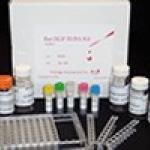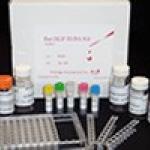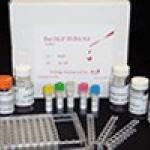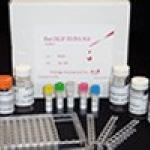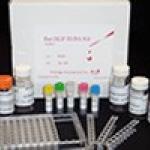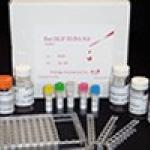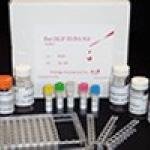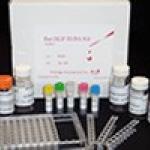-
Specification:96TestDescription:
Neuropeptide Y (NPY) is a 36 amino acid peptide neurotransmitter found in the brain and autonomic nervous system.
NPY has been associated with a number of physiologic processes in the brain, including the regulation of energy balance, memory and learning, and epilepsy. The main effect is increased food intake and…
-
Specification:96TestDescription:
The glycolytic enzyme enolase (2-phosph-D-glycerate hydrolyase) exists as several dimeric isoenzymes (aa, ab, ag and gg) composed of three distinct subunits, a, b, and g. Three isoenzymes are found in human brain: aa, ag and gg. The ag and gg-enolase isoenzymes are also known as neuron?-specific enolase (NSE) as…
-
Specification:96TestDescription:
3-Nitrotyrosine is one of the most common products of the action of reactive nitrogen species on proteins. It may be considered as a marker of NO·-dependent oxidative damage. Numerous studies on the formation of 3-nitrotyrosine and related molecules have yielded little information about the subsequent behavior and…
-
Specification:96TestDescription:
Neurotensin (NT) is an endogenous tridecapeptide neurotransmitter (pGlu-Leu-Tyr-Glu-Asn-Lys-Pro-Arg-Arg-pro-Tyr-Ile-Leu-OH) that was originally isolated from bovine hypothalamus. NT influences distinct central and peripheral physiological functions in mammals. Central administration of NT modulates dopaminergic…
-
Specification:96TestDescription:
Neurotrophins are a family of proteins that induce the survival, development and function of neurons. They belong to a class of growth factors, secreted proteins, which are capable of signaling particular cells to survive, differentiate, or grow. Growth factors such as neurotrophins that promote the survival of…
-
Specification:96TestDescription:
The osteogenic growth peptide (OGP) is an extracellular mitogen identical to the histone H4 COOH-terminal residues 90–103, which regulates osteogenesis and hematopoiesis. By Northern analysis, OGP mRNA is indistinguishable from H4 mRNA. Indeed, cells transfected with a construct encoding H4 secreted the…
-
Specification:96TestDescription:
Brain-type Natriuretic Peptide (BNP) is a nonglycosylated peptide that is produced predominantly by ventricular myocytes and belongs to the natriuretic peptide family. Plasma NT-proBNP is a marker for congestive heart failure, while mature BNP (aa 103 - 134) promotes vasodilation and fluid and sodium excretion.
-
Specification:96TestDescription:
Trypsin is a serine protease found in the digestive system of many vertebrates, where it hydrolyses proteins. Trypsin is produced in the pancreas as the inactive proenzyme trypsinogen. Trypsin predominantly cleaves peptide chains at the carboxyl side of the amino acids lysine or arginine, except when either is…
-
Specification:96TestDescription:
Thyroid-stimulating hormone (TSH) is secreted by the anterior lobe of the pituitary gland and induces the production and release thyroid hormones thyroxin (T4) and triiodothryronine (T3). These thyroid hormones exert a negative feedback on the pituitary. The release of TSH is regulated by TSH-releasing hormone (TRH…
-
Specification:96TestDescription:
Nuclear Factor Kappa B(NFkB) is a 105 kD protein which can undergo cotranslational processing by the 26S proteasome to produce a 50 kD protein. The 105 kD protein is a Rel protein-specific transcription inhibitor and the 50 kD protein is a DNA binding subunit of the NF-kappaB (NF-κB) protein complex.
NF-κB is a…
 Specification:96TestDescription: Neuropeptide Y (NPY) is a 36 amino acid peptide neurotransmitter found in the brain and autonomic nervous system. NPY has been associated with a number of physiologic processes in the brain, including the regulation of energy balance, memory and learning, and epilepsy. The main effect is increased food intake and…
Specification:96TestDescription: Neuropeptide Y (NPY) is a 36 amino acid peptide neurotransmitter found in the brain and autonomic nervous system. NPY has been associated with a number of physiologic processes in the brain, including the regulation of energy balance, memory and learning, and epilepsy. The main effect is increased food intake and… Specification:96TestDescription: The glycolytic enzyme enolase (2-phosph-D-glycerate hydrolyase) exists as several dimeric isoenzymes (aa, ab, ag and gg) composed of three distinct subunits, a, b, and g. Three isoenzymes are found in human brain: aa, ag and gg. The ag and gg-enolase isoenzymes are also known as neuron?-specific enolase (NSE) as…
Specification:96TestDescription: The glycolytic enzyme enolase (2-phosph-D-glycerate hydrolyase) exists as several dimeric isoenzymes (aa, ab, ag and gg) composed of three distinct subunits, a, b, and g. Three isoenzymes are found in human brain: aa, ag and gg. The ag and gg-enolase isoenzymes are also known as neuron?-specific enolase (NSE) as… Specification:96TestDescription: 3-Nitrotyrosine is one of the most common products of the action of reactive nitrogen species on proteins. It may be considered as a marker of NO·-dependent oxidative damage. Numerous studies on the formation of 3-nitrotyrosine and related molecules have yielded little information about the subsequent behavior and…
Specification:96TestDescription: 3-Nitrotyrosine is one of the most common products of the action of reactive nitrogen species on proteins. It may be considered as a marker of NO·-dependent oxidative damage. Numerous studies on the formation of 3-nitrotyrosine and related molecules have yielded little information about the subsequent behavior and… Specification:96TestDescription: Neurotensin (NT) is an endogenous tridecapeptide neurotransmitter (pGlu-Leu-Tyr-Glu-Asn-Lys-Pro-Arg-Arg-pro-Tyr-Ile-Leu-OH) that was originally isolated from bovine hypothalamus. NT influences distinct central and peripheral physiological functions in mammals. Central administration of NT modulates dopaminergic…
Specification:96TestDescription: Neurotensin (NT) is an endogenous tridecapeptide neurotransmitter (pGlu-Leu-Tyr-Glu-Asn-Lys-Pro-Arg-Arg-pro-Tyr-Ile-Leu-OH) that was originally isolated from bovine hypothalamus. NT influences distinct central and peripheral physiological functions in mammals. Central administration of NT modulates dopaminergic… Specification:96TestDescription: Neurotrophins are a family of proteins that induce the survival, development and function of neurons. They belong to a class of growth factors, secreted proteins, which are capable of signaling particular cells to survive, differentiate, or grow. Growth factors such as neurotrophins that promote the survival of…
Specification:96TestDescription: Neurotrophins are a family of proteins that induce the survival, development and function of neurons. They belong to a class of growth factors, secreted proteins, which are capable of signaling particular cells to survive, differentiate, or grow. Growth factors such as neurotrophins that promote the survival of… Specification:96TestDescription: The osteogenic growth peptide (OGP) is an extracellular mitogen identical to the histone H4 COOH-terminal residues 90–103, which regulates osteogenesis and hematopoiesis. By Northern analysis, OGP mRNA is indistinguishable from H4 mRNA. Indeed, cells transfected with a construct encoding H4 secreted the…
Specification:96TestDescription: The osteogenic growth peptide (OGP) is an extracellular mitogen identical to the histone H4 COOH-terminal residues 90–103, which regulates osteogenesis and hematopoiesis. By Northern analysis, OGP mRNA is indistinguishable from H4 mRNA. Indeed, cells transfected with a construct encoding H4 secreted the… Specification:96TestDescription: Brain-type Natriuretic Peptide (BNP) is a nonglycosylated peptide that is produced predominantly by ventricular myocytes and belongs to the natriuretic peptide family. Plasma NT-proBNP is a marker for congestive heart failure, while mature BNP (aa 103 - 134) promotes vasodilation and fluid and sodium excretion.
Specification:96TestDescription: Brain-type Natriuretic Peptide (BNP) is a nonglycosylated peptide that is produced predominantly by ventricular myocytes and belongs to the natriuretic peptide family. Plasma NT-proBNP is a marker for congestive heart failure, while mature BNP (aa 103 - 134) promotes vasodilation and fluid and sodium excretion. Specification:96TestDescription: Trypsin is a serine protease found in the digestive system of many vertebrates, where it hydrolyses proteins. Trypsin is produced in the pancreas as the inactive proenzyme trypsinogen. Trypsin predominantly cleaves peptide chains at the carboxyl side of the amino acids lysine or arginine, except when either is…
Specification:96TestDescription: Trypsin is a serine protease found in the digestive system of many vertebrates, where it hydrolyses proteins. Trypsin is produced in the pancreas as the inactive proenzyme trypsinogen. Trypsin predominantly cleaves peptide chains at the carboxyl side of the amino acids lysine or arginine, except when either is… Specification:96TestDescription: Thyroid-stimulating hormone (TSH) is secreted by the anterior lobe of the pituitary gland and induces the production and release thyroid hormones thyroxin (T4) and triiodothryronine (T3). These thyroid hormones exert a negative feedback on the pituitary. The release of TSH is regulated by TSH-releasing hormone (TRH…
Specification:96TestDescription: Thyroid-stimulating hormone (TSH) is secreted by the anterior lobe of the pituitary gland and induces the production and release thyroid hormones thyroxin (T4) and triiodothryronine (T3). These thyroid hormones exert a negative feedback on the pituitary. The release of TSH is regulated by TSH-releasing hormone (TRH… Specification:96TestDescription: Nuclear Factor Kappa B(NFkB) is a 105 kD protein which can undergo cotranslational processing by the 26S proteasome to produce a 50 kD protein. The 105 kD protein is a Rel protein-specific transcription inhibitor and the 50 kD protein is a DNA binding subunit of the NF-kappaB (NF-κB) protein complex. NF-κB is a…
Specification:96TestDescription: Nuclear Factor Kappa B(NFkB) is a 105 kD protein which can undergo cotranslational processing by the 26S proteasome to produce a 50 kD protein. The 105 kD protein is a Rel protein-specific transcription inhibitor and the 50 kD protein is a DNA binding subunit of the NF-kappaB (NF-κB) protein complex. NF-κB is a…
